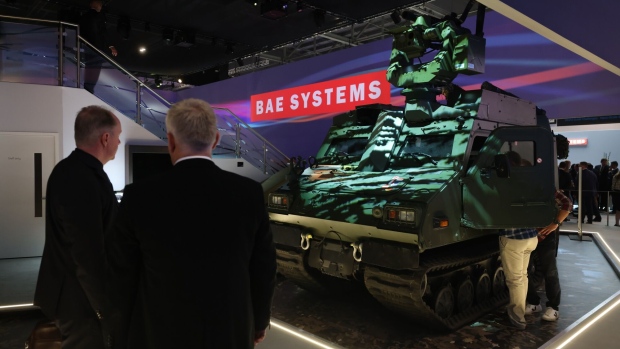Apr 10, 2024
Defense Stock Wobble Raises Concern About Stretched Valuations
, Bloomberg News

(Bloomberg) -- Shares in defense companies jumped after Russia’s attack on Ukraine. They did again after the Israel-Hamas conflict started. Now another surge driven by Europe’s mission to boost military spending is raising questions over whether they’ve gone too far, too fast.
The seven biggest European publicly traded makers of military hardware — including Rheinmetall AG, BAE Systems Plc and Saab AB — sank on Tuesday as investors lost their nerve around record share prices. Even with the pullback, they’ve added a combined $30 billion or so to their stock market value in 2024.
The advance reflected the new geopolitical reality for Europe in the face of Russian aggression and American stalling over future funding for Ukraine. Investors expect orders to come thick and fast as countries reconfigure their military capabilities. But some analysts are skeptical, and European leaders are divided over how to do it.
Germany is pressing on with an overhaul of its armed forces, with orders worth as much as €7 billion ($7.6 billion), people familiar with the plans said earlier this week. They include a contract for armored transporters made by Rheinmetall for delivery starting in 2025. Shares in the maker of the Leopard 2 tank, though, dropped 7% on Tuesday from a record.
Goldman Sachs Group Inc. said valuations for European defense stocks now “likely present more downside than upside risk.” Indeed, until this week six of the seven companies were trading above the average price target assigned by analysts.
A basket of defense-exposed European shares tracked by Goldman Sachs has risen 40% year-to-date, even after the wobble this week. The companies collectively look expensive, priced at 20 times their earnings predicted a year from now versus a multiple of 8.6 before Russia invaded Ukraine in February 2022, data compiled by Bloomberg show.
Recent gains were spurred by a European Union agreement in March to establish a “defense industrial strategy” aimed at bolstering military readiness and the arms industry.
US presidential candidate Donald Trump fueled Europe’s push to rearm with threats to abandon NATO partners who don’t meet the alliance’s defense spending requirements. Officials involved in security say that military budgets may need to emulate Cold War spending of as high as 4% of gross domestic product, twice the current NATO target.
“European countries in NATO are being forced to move toward agreed levels of defense spending,” said Patrick Armstrong, chief investment officer at Plurimi Wealth LLP, which owns shares in BAE Systems. “The defense industry will benefit from a structural tail wind in the coming years.”
There are some obstacles, though. There’s debate within the EU how to ramp up aid for Ukraine. Eastern members once in Russia’s orbit, such as the Baltic states, want to procure weapons fast to help Ukraine repel Vladimir Putin’s forces as they gain momentum — even if that means buying abroad in the short term. France, for one, is keen to build up its own defense industry.
The bigger question perhaps is where the money will come from. Many of NATO’s European members still fall well short of the 2% of GDP spending guideline, constrained in part by the EU’s fiscal rules. The EU itself, meanwhile, has set aside only €1.5 billion to fund its new defense strategy.
Alternative proposals to bolster Europe’s military posture — including tapping frozen Russian assets to help finance supplies for Ukraine or to issue common debt to create an EU defense fund — have been controversial.
Morgan Stanley analysts including Ross Law wrote that “limited fiscal headroom in Europe means the rhetoric for higher defense spending is not matched by budgetary reality.” Earnings upgrades will be needed for defense company stocks to keep going, Ross and his colleagues said.
Some are coming. Rheinmetall, whose products also include Fuchs armored transporters, said this month that it expects annual sales to jump to about €10 billion in 2024, up from just over €7 billion a year earlier. But others are cautious.
BAE Systems, which makes Typhoon fighter jets and warships for Britain’s Royal Navy, said after its latest financial update in February that ramping up output will take time because of challenges including recruitment. A plan to increase production of critical 155 millimeter shells in the UK will take as long as two years, Chief Executive Officer Charles Woodburn said.
Concrete evidence of spending and increased geopolitical clarity may now be necessary for the rally to run further. That will come, according to Alexander Neuberger, an analyst at B Metzler Seel Sohn & Co AG who lifted his price target for Rheinmetall last week.
“Assuming the western world still intends to support Ukraine in order to prevent the country from losing the war,” Neuberger said in a note to clients, “there is no alternative to accelerated shipments of ammunition as soon as possible.”
--With assistance from Paul Jarvis, James Cone, Sagarika Jaisinghani and Natalia Drozdiak.
©2024 Bloomberg L.P.







